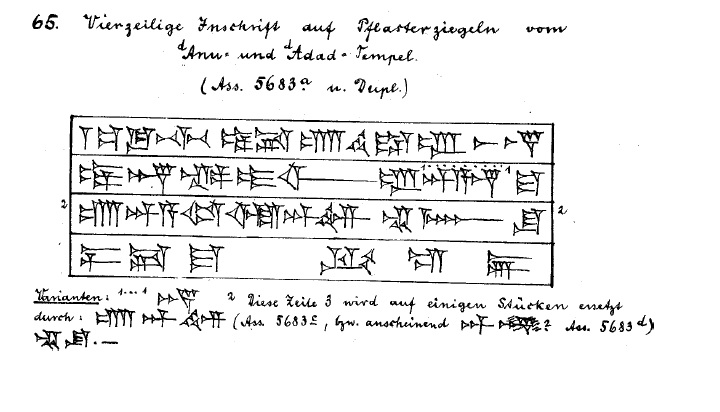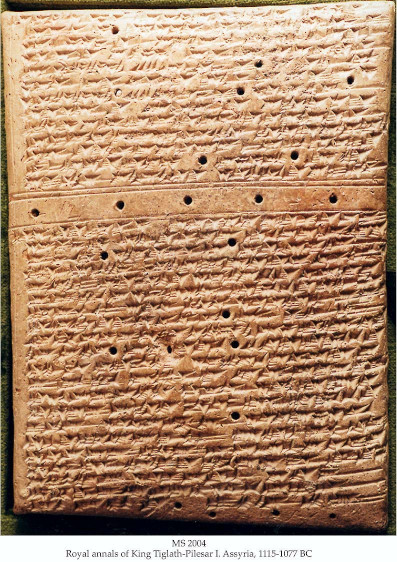Texts nos. 20-31
Browse the RIA 3 Corpus [/riao/ria3/pager/]
20 21 22 23 24 25 26 27 28 29 30 31
20
Please refer to the introduction to text no. 18.
Access the composite text [/riao/ria3/Q005945/] of Tiglath-pileser I 20.
Bibliography
21
This text comes from a broken clay tablet from Nineveh which bears copies of multiple royal inscriptions in the form of a collection. Lines 1'-11' of the preserved portion of the tablet (the top is broken off) is an Ashurnasirpal II [/riao/ria4/index.html] inscription (text no. 53 [/riao/ria4/Q004507/]). The second portion, lines 12-14', is the inscription edited here. It is very likely to be a Tiglath-pileser I text due to its similarity to other inscriptions of this monarch's reign (cf. text 17 [/riao/ria3/Q005942/]). There are discernible traces of a third section preserved on the reverse of the tablet, which may represent a royal inscription earlier than those of Tiglath-pileser, though not enough survives to assign it to any king in particular:
Access the composite text [/riao/ria3/Q005946/] of Tiglath-pileser I 21.
Bibliography
22

KAH 2 no. 65
This text was found on multiple paving bricks in the foundation courtyard of the Anu-Adad Temple at Ashur, and indeed its link to the temple is clear from its content, as it records Tiglath-pileser I's building work there. Bricks with an almost identical inscription, but referencing only the Adad shrine, were found in the same location (see text no. 23 [/riao/ria3/Q005948/].) It is possible to infer from this that there may have been bricks bearing a text which commemorates only the work done on the Anu shrine, however this is merely conjecture, as no such bricks have been discovered.
Access the composite text [/riao/ria3/Q005947/] of Tiglath-pileser I 22.
Bibliography
23
As in the case of text no. 22 [/riao/ria3/Q005947/], this text is inscribed on multiple paving bricks from the fountain courtyard at the Anu-Adad Temple in Ashur and concerns itself with Tiglath-pileser's building work at that temple. Many of the bricks bearing this inscription were found in that location among other bricks inscribed with text no. 22 [/riao/ria3/Q005947/] (see the introduction to that text for further comment).
Access the composite text [/riao/ria3/Q005948/] of Tiglath-pileser I 23.
Bibliography
24
This text was found on bricks and brick fragments from Nineveh. The inscription deals with Tiglath-pileser's work in that city on the quay wall facing the River Ḫusir. This text is based on the Walker's systematic study of the majority of the bricks from Nineveh which bear inscriptions of Tiglath-pileser I (i.e. those that he could find in the British Museum). These bricks were discovered by Thompson at the beginning of the twentieth century. According to Walker's identification, the bricks may bear one of five texts. The first two (nos. 24 [/riao/ria3/Q005949/] and 25 [/riao/ria3/Q005950/]) and possibly the third and fourth (nos. 26 [/riao/ria3/Q005951/] and 27 [/riao/ria3/Q005952/]) mention the quay wall facing the River Ḫusir, while the fifth text (no. 28 [/riao/ria3/Q005953/]) consists exclusively of the kings titles.
Access the composite text [/riao/ria3/Q005949/] of Tiglath-pileser I 24.
Bibliography
25
This text, found at Nineveh, is attested on four bricks and brick fragments and deals with Tiglath-pileser I's building work on the quay wall facing the River Ḫusir. For more information on bricks found at Nineveh and concerning this subject matter, see the introduction to text no. 24 [/riao/ria3/Q005949/].
Access the composite text [/riao/ria3/Q005950/] of Tiglath-pileser I 25.
Bibliography
26
A small piece of brick fragment found in Nineveh, bearing a broken text that refers to work on the facing of the key wall of a river, probably the River Ḫusir, as texts nos. 24 [/riao/ria3/Q005949/]-25 [/riao/ria3/Q005950/] commemorate work on that river's quay wall. For more information concerning these bricks, see the introduction to text no. 24.
Access the composite text [/riao/ria3/Q005951/] of Tiglath-pileser I 26.
Bibliography
27
As in the cases of texts nos. 24 [/riao/ria3/Q005949/],25 [/riao/ria3/Q005950/] and 26 [/riao/ria3/Q005951/], this text comes from brick and brick fragments from Nineveh concerning Tiglath-pileser I's work in that city on the quay wall facing a river (probably the River Ḫusir as it is mentioned in texts nos. 24 [/riao/ria3/Q005949/]-25 [/riao/ria3/Q005950/], for more information see the introduction to text no. 24). Uniquely, this text mentions that the wall is "at the garden of the city", probably a royal garden. It is attested on three bricks.
Access the composite text [/riao/ria3/Q005952/] of Tiglath-pileser I 27.
Bibliography
28
This text is found on the edge of bricks and brick fragments from both Nineveh and Ashur. It contains only Tiglath-pileser I's name and brief titulary. There are a few slight variations: line 1 mGIŠ.[tukultī-...], line 2 AŠ for aš-šur.
Access the composite text [/riao/ria3/Q005953/] of Tiglath-pileser I 28.
Bibliography
29
This brief text assigns the multiple stone slabs on which it was inscribed to the "house of boxwood". The -- generally fragmentary -- slabs were found at Tiglath-pileser I's palace at Ashur. According to Grayson's assessment, many of these fragments probably could be joined if the originals were subject to more detailed study. As it is, the following collation is based on photos. Ex. 6 deviates slightly from the other copies: Scheil's copy shows that it omits mGIŠ. in line 1 and uses -A- instead of -IBILA-.
Access the composite text [/riao/ria3/Q005954/] of Tiglath-pileser I 29.
Bibliography
30
As this object was not available for study no edition is given here. The text is reportedly written on a tile (possibly of clay) which was found at Ashur and bears the name of the king, Tiglath-pileser. It was discovered in secondary use in the eastern wall of a room to the east of the "Tiled Room" in the Old Palace.
Access the composite text [/riao/ria3/Q005955/] of Tiglath-pileser I 30.
Bibliography
31

© 2020 The Schoyen Collection
A Large clay tablet bears this inscription, which is dated to the eponym of Aššur-šaʾissunu (possibly 1079 BC), records the military campaigns from Babylonia, to Syria and Lebanon, with greater detail on the two Babylonian campaigns in lines 24-48, for which this text offers new information not present in other texts of this ruler. A building section is dedicated to the record of the works on the city wall of Pakute (region of the Diyala River), the moat around the city and on a palace inside it (ll. 49-63a).
Access the composite text [/riao/ria3/Q006686/] of Tiglath-pileser I 31.
Bibliography
Jamie Novotny & Poppy Tushingham
Jamie Novotny & Poppy Tushingham, 'Texts nos. 20-31', The Royal Inscriptions of Assyria online (RIAo) Project, The RIAo Project, a sub-project of MOCCI, 2023 [http://oracc.museum.upenn.edu/riao/thekingdomofassyria1114884bc/tiglathpileseri/texts2031/]